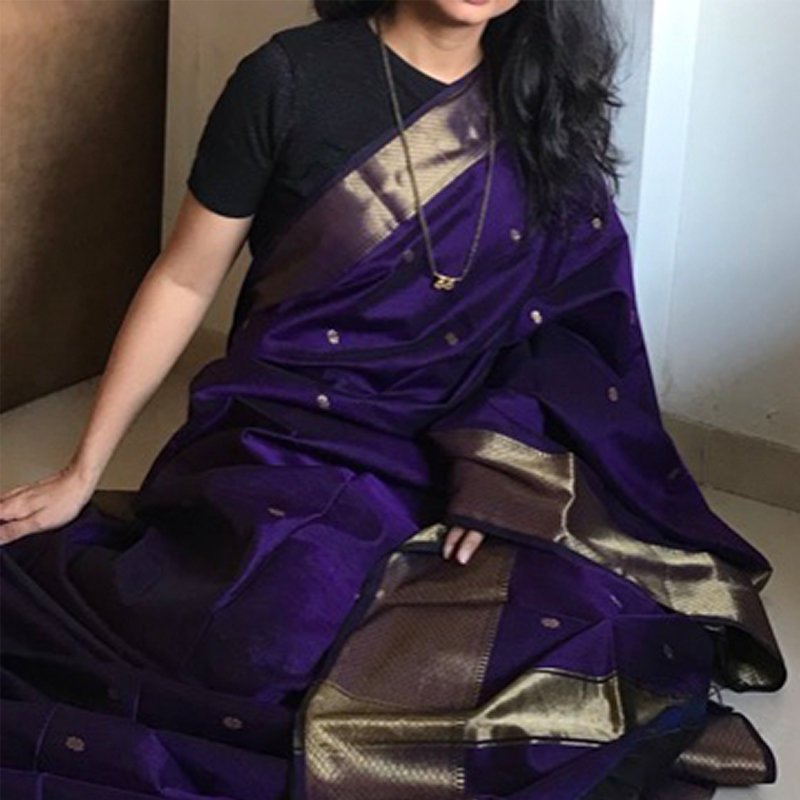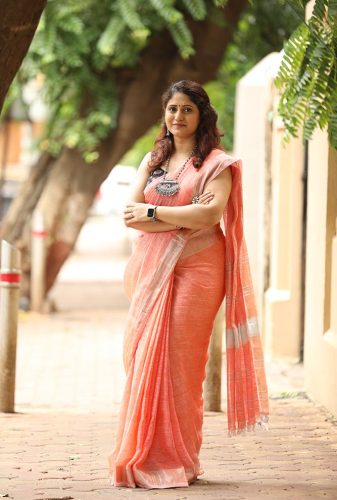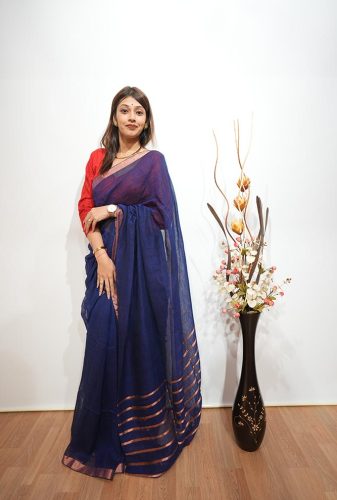
What exactly is Linen?
Linen sarees hold a cherished spot in Indian textile heritage, blending tradition with contemporary style. From their colonial-era luxury status to their modern-day popularity, linen sarees have woven a remarkable journey, captivating fashion enthusiasts across generations. Join us as we explore the history, characteristics, and enduring charm of linen sarees.
What Exactly is Linen?
Linen is a natural textile made from the fibres of the flax plant (Linum usitatissimum). It's one of the oldest and most cherished fabrics known to humankind, prized for its exceptional strength, breathability, and luxurious texture. Linen has been cultivated for thousands of years and has played a significant role in various cultures around the world.
Production Process
The production of linen begins with the cultivation of flax plants, primarily in regions with temperate climates, such as Western Europe, particularly Belgium, France, and Ireland. After harvesting, the flax stems undergo a process called retting, where they are soaked in water to separate the fibres from the woody stalks. This can be done through dew retting (exposure to moisture in the field) or water retting (submerging in water). Once retted, the fibres are dried, spun into yarn, and woven into fabric.
A Journey Through History of Linen Sarees
The history of linen sarees in India is a fascinating tale of cultural exchange, craftsmanship, and innovation. While linen itself has ancient origins, its journey into the world of Indian textiles is relatively more recent but significant.
Early Beginnings
Linen, as a fabric, has been known to humans for thousands of years. However, its introduction to India can be traced back to the colonial era when European traders brought linen fabrics to the Indian subcontinent. Initially, linen sarees were primarily imported and were considered a luxury item, often worn by the elite and aristocratic classes.
Influence of British Colonial Rule
During the British colonial period in India, linen sarees gained popularity among British officials and affluent Indians. British women living in India favoured the lightweight and breathable nature of linen, especially in the hot and humid climate. This led to an increased demand for linen sarees, prompting Indian weavers to experiment with weaving linen fibres alongside traditional Indian techniques.
Fusion of Cultures
As Indian weavers began incorporating linen into their repertoire, a beautiful fusion of cultures emerged. Traditional Indian motifs, designs, and weaving techniques were combined with linen fabric, resulting in sarees that were both elegant and distinctive. These linen sarees often featured intricate embroidery, zari work, and handloom weaving, showcasing the skill and creativity of Indian artisans.
Rise in Popularity
Over time, linen sarees gained popularity not only among the elite but also among the middle class. Their lightweight and breathable nature made them ideal for everyday wear, especially during the scorching Indian summers. Linen sarees became a symbol of sophistication and style, favoured by women across different regions of India.
Contemporary Evolution
In modern times, linen sarees continue to be cherished for their timeless elegance and versatility. While traditional handloom techniques are still used to create linen sarees, technological advancements have also led to the production of machine-woven linen fabrics. Contemporary designers have embraced linen sarees, experimenting with colours, patterns, and textures to cater to evolving tastes and preferences.
Linen Vs Cotton
Material Matters
Linen and cotton are both natural fibres, but they have their own unique characteristics. Linen comes from the flax plant, known for its strong and lustrous fibres, while cotton is derived from the cotton plant, offering softer and breathable fibres. Linen fibres are longer and thicker compared to cotton, giving linen its distinctive texture and durability.
Texture Talk
Picture linen fabric as having a crisp yet breathable feel, with its irregularities adding a charmingly rustic touch. On the other hand, cotton is smoother and softer, making it perfect for everyday wear.
Breathability Bonus
Linen’s claim to fame? It has exceptional breathability! Thanks to its natural moisture-wicking properties, linen lets air flow freely, keeping you cool even in the hottest weather. While cotton also breathes well, it might not match linen’s cooling prowess.
Durability Dynamo
Linen isn’t just elegant; it’s tough too! With every wash, linen garments become softer and more supple, proving its remarkable durability. Cotton is durable, too, but linen’s resilience in high-stress situations is hard to beat.
Should you buy linen sarees online? A Quick Guide
- Vast Selection: Online platforms offer a wide range of linen sarees, providing access to diverse designs, colours, and patterns that may not be available locally.
- Convenience: Shopping for linen sarees online allows you to browse and purchase from the comfort of your home, eliminating the need to visit multiple stores physically.
- Detailed Descriptions: Look for detailed product descriptions and specifications provided by online sellers. This information helps you understand the fabric quality, weave, and other essential details before making a purchase.
- Customer Reviews: Take advantage of customer reviews and ratings to gauge the quality and reliability of the linen sarees offered by different sellers. Genuine feedback from other buyers can help you make an informed decision.
- Return Policies: Check the return and exchange policies of the online store before making a purchase. Ensure that you have the option to return or exchange the saree if it doesn’t meet your expectations or if there are any defects.
- Secure Payment Options: Choose online platforms that offer secure payment options to safeguard your financial information. Look for trusted payment gateways and ensure that the website is encrypted for secure transactions.
- Authenticity: Purchase linen sarees from reputable and trusted online sellers or brands to ensure authenticity and quality. Research the seller's reputation and look for certifications or endorsements that validate their credibility.
- Check Sizing: Pay attention to the sizing charts provided by the online store to ensure that you select the correct size for your saree. Additionally, inquire about customization options if you have specific size requirements.
- Shipping and Delivery: Consider the shipping and delivery times when purchasing linen sarees online. Opt for sellers that offer reliable shipping methods and reasonable delivery times to ensure timely receipt of your order.
Conclusion
In the kaleidoscope of Indian fashion, linen sarees shine as timeless classics that transcend trends and seasons. With their exquisite craftsmanship, unparalleled breathability, and enduring allure, linen sarees have carved a special place in the hearts of women across generations. Whether you're drawn to their understated elegance, sustainable appeal, or sheer comfort, linen sarees offer a unique blend of tradition and modernity that speaks volumes about India's rich textile heritage. So, let your saree collection bloom with the timeless beauty of linen as you embrace the grace and sophistication that come with adorning these exquisite garments.







